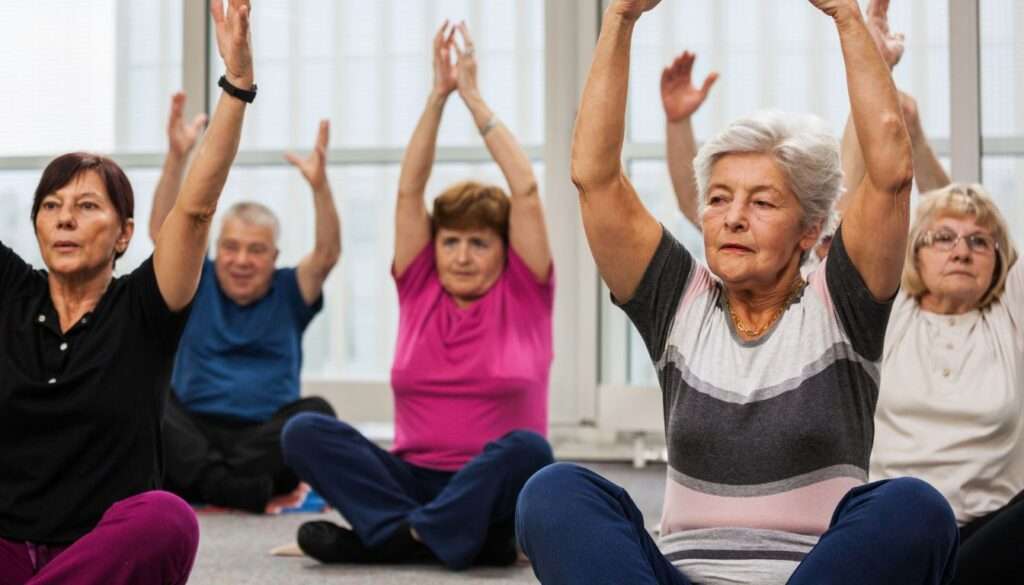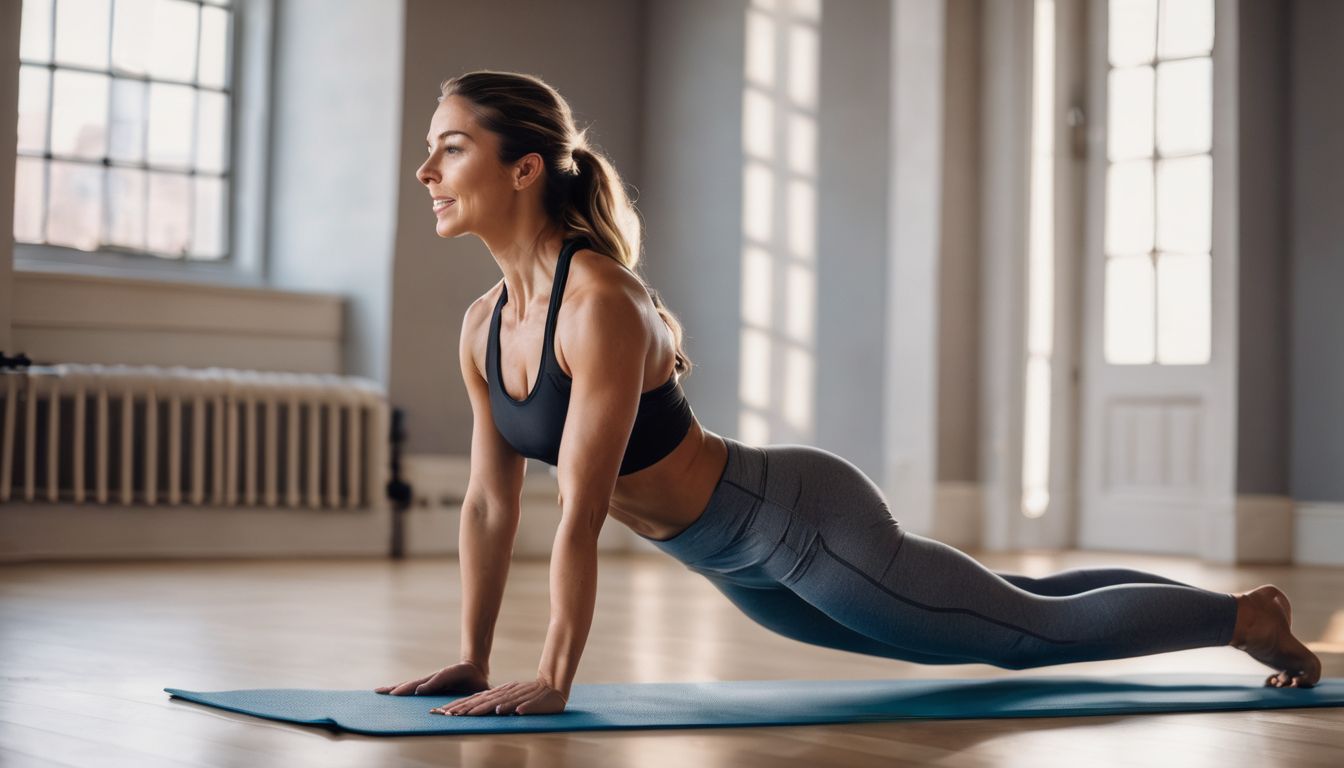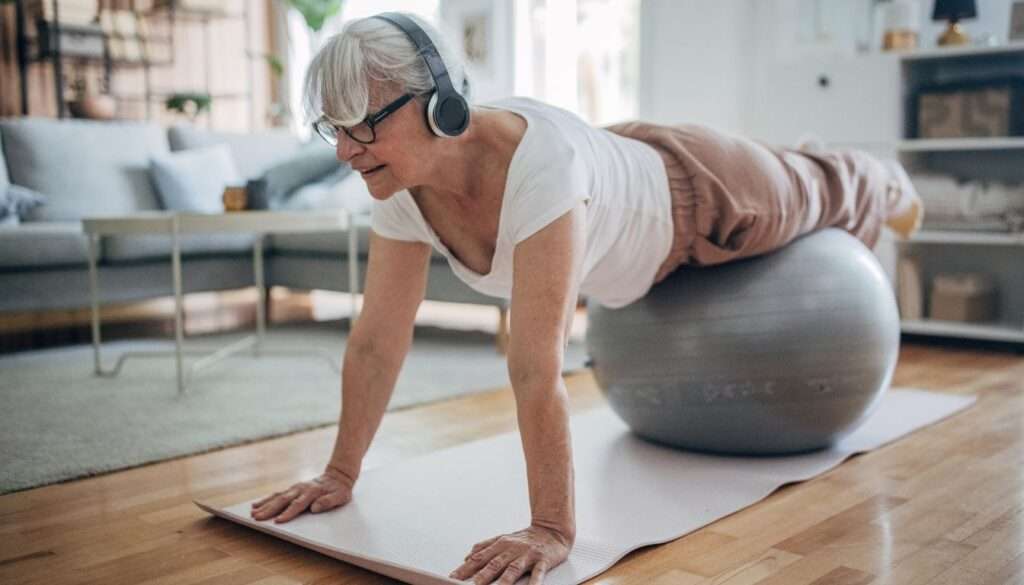Are you wondering if Pilates can really help build muscle, especially as we age? It turns out that this low-impact exercise, designed by Joseph Pilates, is more than just a series of stretches.
This blog will dive into how Pilates supports muscle strength and offers numerous benefits for senior adults’ health. Keep reading to discover the power of Pilates in your golden years!
Key Takeaways
- Pilates strengthens senior adults’ muscles, especially the core, which improves posture and daily function.
- Regular Pilates practice can increase bone density and help manage osteoporosis, reducing the risk of fractures in older adults.
- Chair Pilates provides a safe workout option for seniors with mobility issues, improving strength, flexibility, and balance without strain.
- By focusing on controlled movements and breathing techniques, Pilates enhances joint stability and respiratory health in senior adults.
- Engaging in Pilates helps improve balance through core work and raises body awareness for safer movement among senior citizens.
Understanding Pilates

Pilates is a form of exercise that strengthens the body and mind. It was created by Joseph Pilates, who believed in blending mental focus with physical movement. Through slow, precise moves and breath control, Pilates works both your muscles and your brain.
This method involves a series of movements that target the core muscles. These include the abdominals, lower back, hips, and thighs. The exercises help improve flexibility and strength without adding bulk.
Plus, they teach better posture and breathing techniques.
Older adults find Pilates appealing because it’s low impact and adaptable to different fitness levels. With consistent practice, seniors may notice better joint mobility and less stiffness too.
If you’re looking for an exercise that connects body awareness with controlled movements—give Pilates a try!
Does Pilates Build Muscle?

When it comes to sculpting muscles, Pilates often flies under the radar—yet those who’ve embraced its principles know it packs a punch. Sure, you won’t be hoisting heavy barbells, but through controlled movements and resistance challenges, Pilates can indeed help in strengthening and toning your musculature.
Role of Pilates in muscle building
Pilates really packs a punch for your muscles, especially the core. Those deep abdominal muscles don’t always get worked out in regular gym routines, but Pilates zeroes in on them.
It’s not just about your belly though; this method also targets your back, hips, and glutes – getting all those key areas stronger. We’re talking full-on muscle strength improvement that can help you with everything from carrying groceries to playing with grandkids.
Research backs this up too – studies show older folks doing Pilates beef up their muscle strength and function better day-to-day. Imagine bending down or reaching up high without a strain–that’s what consistent Pilates practice can do for you.
And it’s not just talk; these benefits are real! Some find Pilates even trims the waist and lowers body mass index (BMI) more effectively than some other workouts. So while you might not be building bulk like a bodybuilder, you’re definitely powering up your body in ways that matter for quality of life.
Research evidence supporting muscle building through Pilates
Studies show that Pilates helps seniors build muscle. It targets important stabilizing muscles that support your joints. As you age, these muscles keep you strong and prevent injuries.
Research says Pilates can increase muscle mass, especially in older women. This means better balance and a stronger body.
Experts have seen small to large improvements in how seniors feel because of Pilates. They note less depression, better sleep, and more confidence in avoiding falls. If you’re looking for a way to stay fit and feel great, Pilates could be your answer.
Next up: let’s talk about the specific benefits of Pilates for senior adults.
Benefits of Pilates for Senior Adults

Pilates isn’t just about stretching and core strength—it’s a gateway to a spectrum of remarkable benefits tailored for the golden years. Senior adults often discover that regular Pilates sessions can ignite a transformative journey, enhancing not only their physical wellness but also their mental vitality and emotional balance.
Improved posture
Having a strong core is essential for good posture. Pilates makes your core muscles work hard, which helps keep your body steady and upright. This can make a big difference in how you carry yourself every day.
Think about it like this: Stronger abs and back muscles offer support to the whole spine, acting like a natural corset.
Pilates aligns your body too. That means each bone sits just right, helping seniors stand taller and straighter without even thinking about it. Better alignment takes pressure off joints and can prevent slouching, making movements smoother and easier.
Over time, practicing Pilates could mean saying goodbye to that hunch older adults might start getting as they age.
Enhanced balance and gait
Pilates sharpens your balance and helps you walk better. It trains your body to stand tall and steady. You work on the muscles in your trunk, hips, legs, and ankles. This makes them stronger so you don’t wobble or fall easily.
As you practice Pilates, each step becomes surer and smoother.
Your whole body gets aligned from doing Pilates regularly. This means no part of you is out of place or putting extra strain somewhere else. Your posture gets better, which takes care of a lot of balance problems right there.
Strong legs and a stable core mean less tripping and more confidence when moving around.
Increased mobility
Building on stronger balance and gait, Pilates also opens the door to greater mobility for seniors. It helps loosen tight muscles and lubricate joints. This means you can move more easily and do things like climb stairs, reach for items, or even tie your shoes without strain or discomfort.
With regular practice, you’ll notice getting in and out of chairs becomes smoother. Your walks might get longer because your body feels less stiff. Feeling agile often leads to trying new activities too—maybe a dance class or gardening.
Every movement counts towards keeping you mobile and independent as you age!
Stress reduction and mood improvement
Moving beyond just getting around, Pilates also works wonders for your mind. It’s a powerful mood booster! Think of it like this – Pilates helps you shake off stress and feel happier.
Studies show that older adults who practice Pilates experience less tension, anger, and tiredness. Their emotional health gets a big lift too.
With each session, you might notice you’re feeling calmer and more at peace. Imagine having fewer worries and enjoying better sleep at night—Pilates can make these perks a reality for you.
And the best part? You don’t have to be an expert; even simple Pilates exercises can help brighten your mood and reduce stress levels significantly.
Memory and cognitive thinking enhancement
Pilates exercises do more than just tone your body; they can also sharpen your mind. Regular Pilates sessions send extra blood to your brain, helping grow new cells that are key for memory and learning.
Imagine your brain getting a workout too, each time you stretch and strengthen on the mat.
Many older adults worry about staying sharp as they age. Good news—Pilates could be a game-changer for keeping your thought processes clear and improving cognitive function. Research has found that physical activities like Pilates enhance memory and help with coordination, which is especially important when walking or multitasking.
Think of it as oiling the gears of your mind to keep everything moving smoothly!
Back pain reduction
Living with back pain can feel like a heavy burden. Pilates offers a light at the end of the tunnel by targeting your core and back muscles. Stronger muscles in these areas provide better support for your spine and organs, cutting down on discomfort.
It’s like giving your back a helping hand to hold everything up! In fact, studies show that doing Pilates can ease chronic lower back pain in as little as three months.
If you’re dealing with nagging soreness each day, imagine getting relief and feeling stronger too. That’s what Pilates can bring to your life – more comfort and less pain when you’re enjoying activities or just going about your daily routine.
With practice, those sessions become an investment in a happier spine.
And not only does it help reduce pain; Pilates also boosts immunıty – another great reason to give it a try!
Immunity boost
Reducing back pain is just one piece of the health puzzle for seniors; boosting immunity is another key benefit of Pilates. This low-impact exercise strengthens the body and helps with everyday activities.
It’s not just about building muscles or improving balance. Pilates ramps up your body’s defenses against illness. With each session, you’re enhancing strength, mobility, and proprioception—all vital for a strong immune system.
Seniors find that regular Pilates practice can lead to fewer colds and quicker recovery when sickness does strike. Stronger muscles support better overall health which, in turn, keeps the immune system robust.
Remember, a resilient body is less prone to infections and has a greater ability to bounce back from illnesses that often hit older adults harder.
Injury prevention
Pilates does more than just tone your body; it’s big on injury prevention too. The exercises focus on control and precision, training muscles to work together in harmony. This means you’re less likely to get hurt doing everyday things because your body is better at moving as one unit.
Think about how often you reach, twist, or bend down – Pilates makes these movements safer by strengthening the core and teaching proper alignment.
For older adults, staying safe while active is crucial. Since Pilates improves balance and gait, there’s a smaller chance of falling. Stronger muscles support joints better, reducing the risk of strains or sprains.
With regular practice, seniors can keep enjoying their daily activities without fear of injury.
Now let’s consider some special considerations for senior adults practicing Pilates..
Special Considerations for Senior Adults Practicing Pilates

Senior adults need to think about their safety when doing Pilates. Start with exercises that match your health and fitness level. If you have a chronic condition like heart disease or arthritis, talk to your doctor before starting Pilates.
Choose classes designed for seniors so the moves are right for you.
It’s also important to go at your own pace. Avoid pushing yourself too hard and focus on slow, steady progress. Keep in mind that balance may be an issue as you age. Use chairs or other support if needed to help keep stable during workouts.
Remember, regular practice will lead to the best results!
Pilates and Bone Density
Discover how the precise movements in Pilates not only grace you with a stronger core but may also be your silent ally in the fight against bone loss, especially crucial as we step into our golden years—dive deeper to see this gentle exercise’s impact on bone health.
The impact of Pilates on bone density
Pilates isn’t just about flexibility and muscle tone—it also helps bones get stronger. For folks worried about bone thinning, like postmenopausal women, Pilates can be a real game changer.
Using the Reformer or Tower in Pilates makes your muscles push and pull against springs. This resistance is key for building up bone density.
Stronger bones mean less risk of fractures and osteoporosis. It’s important to keep our skeletons sturdy as we age, and Pilates offers a safe way to do that. With consistent practice, you might find yourself standing taller and feeling more solid on your feet.
Plus, who wouldn’t want an exercise that keeps both muscles and bones in top shape? Next up: how Pilates manages osteoporosis for those already facing it.
Role of Pilates in osteoporosis management
Pilates can be a game-changer for those facing osteoporosis. This condition makes bones brittle and more prone to breaks. But with regular Pilates, you’re doing weight-bearing exercises that challenge your muscles and bones.
These movements help increase bone density, making them stronger.
Exercises on Pilates equipment like the Reformer or Tower add resistance through springs. This resistance works like lifting weights without the heavy load. It pushes your body to build up bone mass just where you need it most.
For postmenopausal women, who often see a dip in bone density, Pilates could be a vital part of staying strong and avoiding broken bones as they age.
Chair Pilates for Senior Adults
Chair Pilates, tailored for senior adults, unlocks the world of fitness by merging comfort with effectiveness, providing a gateway to better health without the strain—discover how this innovative approach can redefine your wellness journey.
Concept of Chair Pilates
Chair Pilates is a form of exercise that adapts the classic Pilates method for people who have trouble with floor exercises. It’s great for seniors because it improves fitness without being too hard on your body.
You’ll use a chair to support yourself while doing movements that help build strength and flexibility in a safe way. This type of Pilates keeps you stable as you work out, making it perfect if you’re worried about balance.
This workout style lets seniors stay seated while getting all the core-strengthening benefits Pilates offers. You don’t need any fancy equipment—just a sturdy chair—and you can modify each move to fit your comfort level.
Doctors often suggest Chair Pilates as an effective low-impact workout option, especially for those with reduced mobility or health concerns that make standing or lying down tricky.
Benefits of Chair Pilates for senior adults
Chair Pilates offers a unique exercise option for older adults. It caters to those with varying levels of mobility and space, providing a safe way to stay active.
- Safe and Accessible: You can perform Chair Pilates sitting down, which makes it safer if you have balance issues or worry about falling.
- Strengthens Core: This form of Pilates targets your core muscles. A strong core helps support your spine and organs.
- Boosts Joint Health: Gentle movements improve joint mobility without putting too much pressure on them.
- Enhances Posture: Regular sessions can lead to better posture. Good posture is key to reducing back pain.
- Improves Flexibility: You’ll work on stretching different muscle groups which helps keep you limber and less prone to injuries.
- Encourages Better Balance: Exercises aim at improving your balance by strengthening the muscles that keep you upright.
- Increases Muscle Tone: With consistent practice, you’ll notice firmer muscles especially in your arms, legs, and stomach area.
- Reduces Stress: Focusing on breathing techniques during practice can help reduce stress and calm your mind.
- Adaptable Routines: Instructors can modify exercises to fit your needs, so don’t worry if certain movements are tough at first.
- Promotes Circulation: Moving regularly helps get your blood flowing properly throughout your body.
- Fosters Independence: With increased strength and stability, daily tasks may become easier helping you maintain independence as you age.
Pilates and Joint Stability
Pilates isn’t just about that core strength—its precise, controlled movements are a boon for joint stability too, especially helpful as we navigate the golden years; dive in to discover how it supports our creaky hinges!
How Pilates improves joint stability
Pilates can be a great friend to your joints. It strengthens the muscles around them, giving you steadier balance and muscle power. This means your knees, hips, and shoulders can move smoothly with less chance of twists or sprains.
For older adults especially, stronger joint support helps you stand firm and keep walking confidently.
Think of Pilates as gentle coaching for your body’s connections. Each exercise works to make these spots more stable. Over time, you may notice that standing on one leg feels easier or climbing stairs is no trouble at all.
Keeping up with Pilates could mean saying goodbye to wobbly ankles and hello to sturdy steps every day!
The role of Pilates in improving joint mobility
Building on joint stability, Pilates also works wonders for your joint mobility. It’s like greasing a creaky door hinge—movement becomes smoother and less stiff. As you age, keeping joints mobile is key to doing everyday things with ease, be it reaching up to grab something or bending down to tie your shoes.
Through gentle stretches and controlled movements, Pilates helps increase the range of motion in your joints. This means less pain and better movement when playing with grandkids or gardening.
Pilates exercises often focus on the hips, shoulders, and spine—areas that tend to lock up over time. Regular practice can lead to joints feeling more fluid and less prone to injury.
Think about it as regular maintenance for your body; just like a car needs oil changes, your joints need Pilates to keep them running smoothly!
Pilates for Improved Breathing and Circulation
Discover the transformative power of Pilates as it not only enhances your posture and core strength but also breathes new life into your respiratory and circulatory systems—vital components for maintaining vigor and vitality, especially as we age; dive deeper to understand how!
The impact of Pilates on respiratory health
Pilates does wonders for your lungs and breathing. Specific movements in Pilates make you breathe deeply and evenly, which can pump more air into every part of your lungs. This helps to increase lung capacity and gets more oxygen to your body.
Doing these exercises often can lead to better respiratory health. You might even feel like taking deep, refreshing breaths is easier after sticking with Pilates for a while. It’s like giving your lungs a good workout that makes them stronger over time.
How Pilates enhances circulation
Pumping blood gets easier with Pilates. It works your core and keeps the body aligned. This alignment helps blood flow better all through you. Think of it as a highway for your bloodstream, clear and open.
With each move, you’re pushing oxygen-rich blood to every part of your body. Even deep breaths during exercises help this process. These are key tricks to keep circulation strong, vital for good health as we age.
Pilates for Balance and Body Awareness
Discover how the precision of Pilates can revolutionize your sense of stability and self-perception, sharpening balance and enhancing body awareness for senior adults—let’s dive into these transformative benefits.
How Pilates enhances balance
Pilates focuses on core strength, which is key for good balance. Core muscles help you stay upright and steady. With Pilates, your body learns to control movements better. This means fewer falls and more confidence walking or doing other activities.
It also includes exercises that make your legs stronger and more stable. Stronger leg muscles support your whole body better. Over time, this training makes it easier to stand on one foot or walk on uneven surfaces without losing your balance.
The role of Pilates in improving body awareness
Body awareness is key for moving well and avoiding falls. Pilates gives this awareness a boost. It focuses on your core, which connects to better balance and sharper sensing of where your body is in space.
As we age, those senses might dull, but Pilates keeps them sharp. This way, you can stay active and steer clear of injuries.
Through these exercises, seniors fine-tune their coordination and control. Each movement in Pilates requires attention to how the body parts align and work together. Active practice leads to increased body knowledge; this means making daily tasks easier and safer.
Over time, you’ll walk with more confidence knowing your body’s limits and abilities.
Pilates for Strength and Flexibility
Transform your body’s core strength and flexibility with Pilates, a comprehensive exercise routine that not only revitalizes your muscles but also brings a newfound agility into everyday movements—discover the full spectrum of these benefits as we delve deeper.
How Pilates enhances strength
Pilates strengthens muscles with low-impact exercises. It focuses on the core, which includes the belly, back, and hips. A strong core leads to better posture and less back pain. These exercises target deep muscles you don’t hit in other workouts.
By holding poses and moving slowly, Pilates builds strength without bulking up.
You’ll work on your arms, legs, and glutes too. Think of it like a full-body tune-up that tightens and tones all over. Pilates makes everyday tasks easier by building muscle endurance as well.
With stronger muscles, climbing stairs or carrying groceries feels less tough!
The role of Pilates in improving flexibility
Gaining flexibility is important as we age, and Pilates can be a game-changer here. It works by stretching the muscles while also strengthening them, which may seem different from typical workouts that focus on either one or the other.
Think of your muscles like rubber bands. With regular Pilates practice, these ‘rubber bands’ become longer and more elastic, allowing for easier movement in joints and a wider range of motion.
Imagine reaching down to tie your shoe or twisting to look behind you with ease—Pilates helps make this possible. As older adults incorporate Pilates into their exercise routine, they often notice they can move more freely in their daily activities.
This isn’t just about feeling good; it’s about maintaining independence and quality of life.
Next up: Chair Pilates—that’s right, all the benefits of traditional Pilates but done sitting down!
Conclusion.
Pilates really does wonders for building muscle, specially in senior adults. It’s more than just a workout; it’s a way to strengthen your body and keep you moving freely. Plus, it helps with balance and keeping bones strong.
So yes, older folks can trust Pilates to stay fit and healthy!
FAQs
1. Can seniors really get stronger by doing Pilates?
Absolutely! Seniors can build muscle and improve physical fitness with Pilates, which uses resistance exercise geared towards aging bodies.
2. Will Pilates help prevent falls in older adults?
Yes, it will. Pilates boosts balance training and strengthens core muscles, helping prevent falls—a big plus for seniors’ well-being!
3. Does practicing Pilates have mental health benefits for the elderly?
For sure—it’s a mind-body intervention that helps lower anxiety and supports mental health among senior adults.
4. Is there scientific proof that Pilates is good for chronic diseases common in older people?
Definitely! There’s plenty of evidence from randomized-controlled trials showing how Pilates can manage conditions like type II diabetes and cardiovascular disease.
5. Does doing Pilates affect bone density in older individuals?
You bet! Weight-bearing exercises like those found in the system called ‘Pilates principles’, developed by Josef H. Pilate may combat loss of bone density seen during the aging process.
6. Could a regular routine at a local pilate studio improve my overall health as I age?
Joining sessions at a nearby studios not only promotes muscle extension but also contributes to overall health promotion – key factors to consider if you’re looking to maintain vitality through your senior years.





